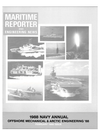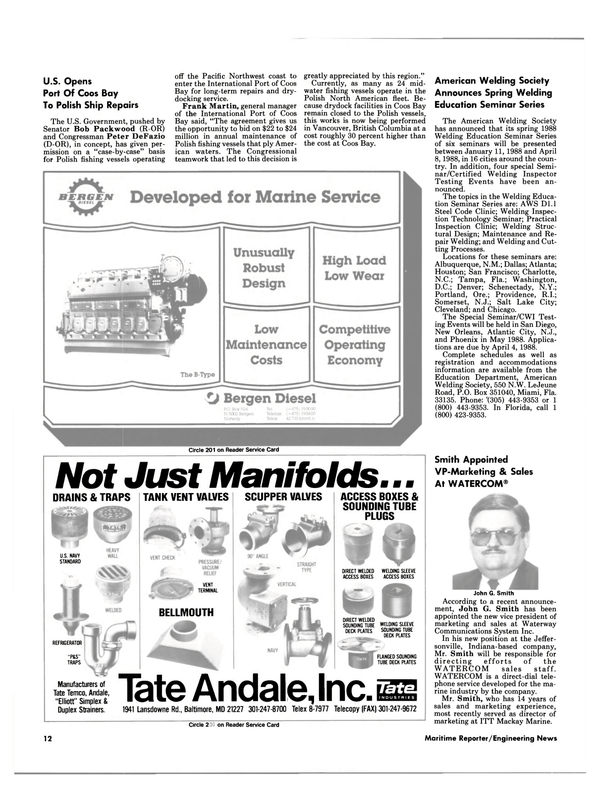
Cruise Ship Industry Spurs Construction in Italian Yards
The Italian cruise ship industry is providing work for the country's shipyards, including both major refits and newbuildings. Sitmar Lines has commissioned three new cruise ships, two of which are being built in Italy, and Costa Crociere, a newly formed company coordinating the activities of Costa cruise ships, has invested more than $20 million to refit their flagship, the Eugenio Costa.
These developments show a considerable confidence in the future of the cruise industry on the part of the private sector. Additionally, positive legislative support by the Italian government was a contributing factor. Recent Italian legislation provides some financial support for both shipowners and shipyards.
However, government subsidies alone cannot make an industry flourish. It seems that both Sitmar and the Costa Lines see a real future in the cruise ship market. Both companies apparently believe that this market has undergone, and is undergoing substantial changes, and are committed to designing their ships and cruise itineraries with new market demands, and a newly drawn customer profile.
Costa Crociere commissioned the Mariotti yard in Genoa to remodel their flagship, Eugenio Costa. The 30,500-ton ship, originally launched in 1966, left the yard late last year after a two-month stay to take up her winter cruising schedule in South America.
Company spokesmen emphasized that the refit was no mere "facelift," but rather a major transformation of the ship's covered and open deck areas. The newly transformed Eugenio, descibed in company literature as the world's first floating tourist resort, is not aimed at the traditional cruise passenger market. The company has redesigned the Eugenio to appeal to a target market of young, middle to upper middle class couples and families, who in the past may have spent a week's vacation by the sea, rather than on it.
The use of space aboard carefully reflects the priorities of this market.
The Eugenio's architects have conceived a layout which incorporates two parallel and complementary "cities." The first is an "open air city" devoted to daytime activities.
Facilities in this sector include tennis and volleyball courts, jogging tracks, swimming pools, etc.
The second is a "covered city," which incorporates such standard ship's facilities as a cocktail lounge, tea room, library, etc. In this "city," architects have attempted to create a distinctly Italian urban life aboard, with its own shopping street, the Via Veneto, lined with specialty boutiques offering goods from top Italian and European designers.
Like all good shopping streets in Italy, this Via Veneto leads to a Piazza in the Italian style, complete with sculptured fountain, and a sidewalk cafe offering ice cream, drinks and pastries. Clearly, a strong attempt has been made to offer passengers the kind of amenities they would expect to find in a resort town ashore.
The Eugenio's galley was refitted at a cost of about $3.3 million, to permit the preparation of 1,000 meals simultaneously. The dining room was also modified to be able to seat 1,000 passengers and to divide, when necessary, using sliding bulkheads, to accommodate private parties, small conventions, and business groups. About 100 new cabins were added, while existing cabins were redecorated.
The ship's transformation also included the addition of a large structure mounted aft to house a new 600-seat theater. The total cost of the theater was about $4 million.
Costa Crociere is also investing more than $275 million for a new ship of 50,000 tons, due to be delivered in 1991. The 1,500-passenger ship will be used in the Caribbean market.
Two of the three new 1,800-passenger ships ordered by Sitmar Lines, are being built at the Fincantieri yards in Trieste. About 35 percent of the $325 million total cost for each ship is being allotted to the main yard, which is responsible for the design, basic hull deck and superstructure construction, and the coordination of the building. Specialized subcontracting firms supplying outfitting and decor account for 20 percent of the total cost, with the remaining total being allocated to firms supplying engines, machinery, ship's carpentry, etc.
Responsibility for design of the interiors, and overall coordination of the interior outfitting process have been assigned to Giacomo Mortola, a man with extensive experience not only in interior design, but in project management of biannual refits for ships of Sitmar Lines. His company, Gem, also supervised quality control aboard six containerships for Finmare. For the design stage of the new Sitmar project, Mr. Mortola enlisted the services of two specialized design studios, Aras and Arna.
Mr. Mortola maintains that the future of the cruise industry lies with ever larger, more cost-efficient ships. To accommodate a mass market of seagoing "tourists," the bulk of the industry will be seeking to provide an acceptable, if not deluxe, level of comfort and service at a very accessible cost to the customer. A smaller portion of the industry will be providing deluxe service to the high end of the market with small passenger capacity ships. At present in Italy, a 150-passenger ship is under construction in Viareggio and four 70-passenger ships are under construction in La Spezia.
The two Sitmar ships under construction at Fincantieri, both first class vessels of 70,000 tons, are due for delivery in 1990, the first in January, the second in December.
For free literature detailing the ship-repairing and converting facilities at Italian shipyards, Circle 30 on Reader Service Card
Read Cruise Ship Industry Spurs Construction in Italian Yards in Pdf, Flash or Html5 edition of February 1988 Maritime Reporter
Other stories from February 1988 issue
Content
- Almerico to Manage Trinity's Mississippi Shipbuilding Operations page: 5
- New Swagelok Tube Fittings Incorporate Sanitary Flanges page: 5
- Mitsubishi's High-Speed Passenger Boat Promises New Era In Smooth Sailing page: 6
- New Emergency Marker Lights Described In Color Brochure From American Cyanamid Co. page: 6
- New Products From Furuno: Advanced FAP-50 Autopilot, And Weatherfax xWith A Twist' page: 8
- Canadian Shipbuilding And Ship Repairing Association (CSSRA) Becomes CMIA page: 9
- Cruise Ship Industry Spurs Construction in Italian Yards page: 10
- Fincantieri Converting Six Ferries Under $74.4-Million Contract page: 10
- Major U.S. Shipping Companies Form New Industry Association page: 11
- Aluminum Boats Constructing 138-Foot Detroit Diesel-Powered Luxury Dinner/Cruise Vessel page: 11
- Free N ew Color Brochure Features Dampa Products page: 11
- U.S. Opens Port Of Coos Bay To Polish Ship Repairs page: 12
- American Welding Society Announces Spring Welding Education Seminar Series page: 12
- Video Describes Port Design Process And Use Of Simulation page: 13
- Hagglunds To Acquire Dutch Crane Group page: 14
- 5 Canadian Consortiums Contend For $5-Billion Domestic Sub Project page: 15
- Ceramic Coatings Approved By ABS For Diesel Engine Use page: 15
- 7th International Symposium Offshore Mechanics And Arctic Engineering page: 16
- Marine coatings & corrosion control page: 20
- Grow Group, Inc. Announces Personnel Changes page: 24
- Converted Detroit Diesel-Powered Crewboat Includes Airliner Features For Passengers, Cargo page: 25
- Kim Hotstart Pre-Heating Systems Shrink Engine Idling Costs page: 25
- Robertson Autopilot Wins NMEA Honors page: 26
- FULL FUNDING FOR TWO NEW CARRIERS GIVES NAVY 46% INCREASE FOR SHIPBUILDING page: 29
- NAVY RESEARCH AND DEVELOPMENT page: 39
- Southern California Sections Of American Society Of Naval Engineers To Hold Centennial Symposium page: 40
- Navy Plans To Develop ASW Minisubmarine Fleet At Cost Of $5 Billion page: 40
- Navy Shiphandling Simulator Training Expanded page: 41
- $25-Million Navy Order For Caterpillar Generators Announced By H.O. Penn page: 41
- MAJOR NAVY CONTRACTS page: 42
- Navy Secretary Webb Guest Speaker At Joint Meeting Of Propeller Club-U.S.M.M.A. Alumni page: 42
- Ingalls Awarded Navy Contract Worth $378.7 Million To Build Third LHD Ship page: 44
- Bird-Johnson Promotes Ike L. Svensson To GM-Seattle Operations page: 47
- MAN GHH Merges Crane Subsidiaries page: 50
- Fjellstrand Delivers New Design, High-Speed 200-Passenger Ferry page: 51
- Si-Tex Offers Budget Radiotelephone; Reintroduces EZ-7 Loran-C Receiver page: 51
- American Bureau Of Shipping— A 'Class Act' For Over 125 Years page: 52
- Raytheon Introduces New R61 Rasterscan Radar page: 54
- Cummins-Powered 'Traktor Jet' Gives Workboats Unprecedented Thrust page: 54
- Cummins Announces Availability Of New XA' Series Diesel Engines page: 55
- Westmark Completes Acquisition Of Tracor page: 55
- Furuno Introduces New High Resolution Color Radar page: 56
- McDermott Joint Venture Awarded Contract Worth More Than $100 Million page: 56
- New Container Liner Bags Cut Liquid Carriage Costs page: 56
- Bender Posts Successful Recovery From Chapter 11 page: 57
- Spar Associates Awarded Systems Contract By Halifax-Dartmouth page: 61
- Free Brochure On Marine Technical Services Offered By Clyde Leavitt, Inc. page: 62
- EES Corporation Offers Brochure On 'Omnipure' Sewage Treatment Plants page: 62
- Wartsila Diesel Presents A New Auxiliary Engine, The Vasa 2 2 / 26 page: 69


